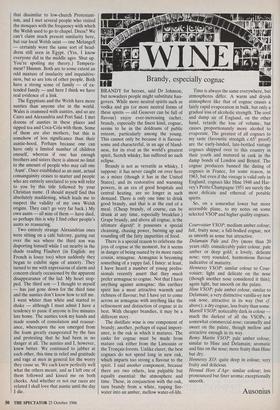Brandy, especially cognac
BRANDY for heroes, said Dr Johnson, but nowadays people might substitute han- govers. While more neutral spirits such as vodka and gin (or more neutral forms of these spirits — old Genever can be full of flavour) enjoy ever-increasing cachet, brandy, especially the finest kind, cognac, seems to be in the doldrums of public esteem, particularly among the young. This cannot only be because it is flavour- some and characterful, in an age of bland- ness, for its rival as the world's greatest spirit, Scotch whisky, has suffered no such eclipse.
Brandy is not as versatile as whisky, I suppose: it has never caught on over here as a mixer (though it has in the United States), and its restorative and warming powers, in an era of good hospitals and central heating, are no longer in such demand. There is only one time to drink good brandy, and that is at the end of a meal. (Cheap brandy, of course, can be drunk at any time, especially breakfast.) Grape brandy, and above all cognac, is the ultimate digesttf: it possesses a special cleansing, chasing power, burning up and rounding off the fatty impurities of food.
There is a special reason to celebrate the joys of cognac at the moment, for it seems in danger of being ousted by its more rustic cousin, armagnac. Armagnac is becoming something of a yuppy fad, I fancy: at least, I have heard a number of young profes- sionals recently assert that they much prefer armagnac to cognac. Not that I have anything against armagnac: this earthier spirit has a most attractive warmth and richness of flavour; but I have yet to come across an armagnac with anything like the refinement and distinction of cognac at its best. With cheaper brandies, it may be a different story.
The distillate wine is one component of brandy; another, perhaps of equal import- ance, is the oak in which it matures. The casks for cognac must be made from mature oak either from the Limousin or the Troncais forests. Unlike claret, the best cognacs do not spend long in new oak, which imparts too strong a flavour to the spirit. I said another component, because there are two others, less palpable but equally essential: the atmosphere and time. These, in conjunction with the oak, turn brandy from a white, rasping fire- water into an amber, mellow water-of-life. Time is always the same everywhere, but atmospheres differ. A warm and dryish atmosphere like that of cognac causes a fairly rapid evaporation in bulk, but only a gradual loss of alcoholic strength. The cool and damp air of England, on the other hand, retards the loss of volume, but causes proportionately more alcohol to evaporate. The greatest of all cognacs to my taste (favourite strength c.65° proof) are the early-landed, late-bottled vintage cognacs shipped over to this country in their youth and matured in cask in the damp bonds of London and Bristol. The cognac producers banned the dating of cognacs in France, for some reason, in 1963, but even if the vintage is valid only in England, cognacs like Hine 1948 and Har- vey's Petite Champagne 1951 are surely the most, delicate and ethereal of potable spirits.
So, on a somewhat lower but more accessible plane, to my notes on some selected VSOP and higher quality cognacs.
Courvoisier VSOP: medium amber colour; full, fruity nose; a full-bodied cognac, not as smooth as some but attractive.
Delamain Pale and Dry (more than 20 years old): considerably paler colour, pale amber or deep gold; a lovely, delicate nose; very rounded, harmonious flavour indicative of maturity.
Hennessy VSOP: similar colour to Cour- voisier; light and delicate on the nose (though another nose considered it thin); again light, but smooth on the palate. Hine VSOP: pale amber colour, similar to Delamain; a very distinctive vanilla-ey new oak nose, attractive in its way (but cf. above); a dry cognac, less fruity than some. Martell VSOP: noticeably dark in colour — much the darkest of all the VSOPs; a somewhat commercial nose; caramelly and sweet on the palate, though mellow and attractive enough in its way.
Remy Martin VSOP: pale amber colour, similar to Hine and Delamain; aromatic and fine on the nose; more fruity than Hine but dry.
Hennessy XO: quite deep in colour; very fruity and delicious.
Heraud Hors d'Age: similar colour; less pronounced but finer aroma; exceptionally smooth.
Ausonius


























































 Previous page
Previous page